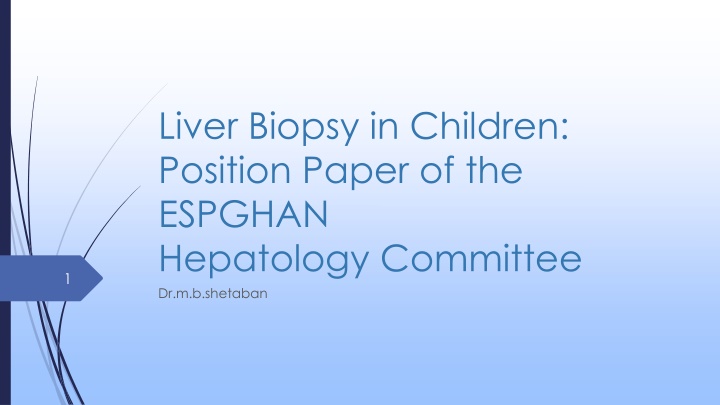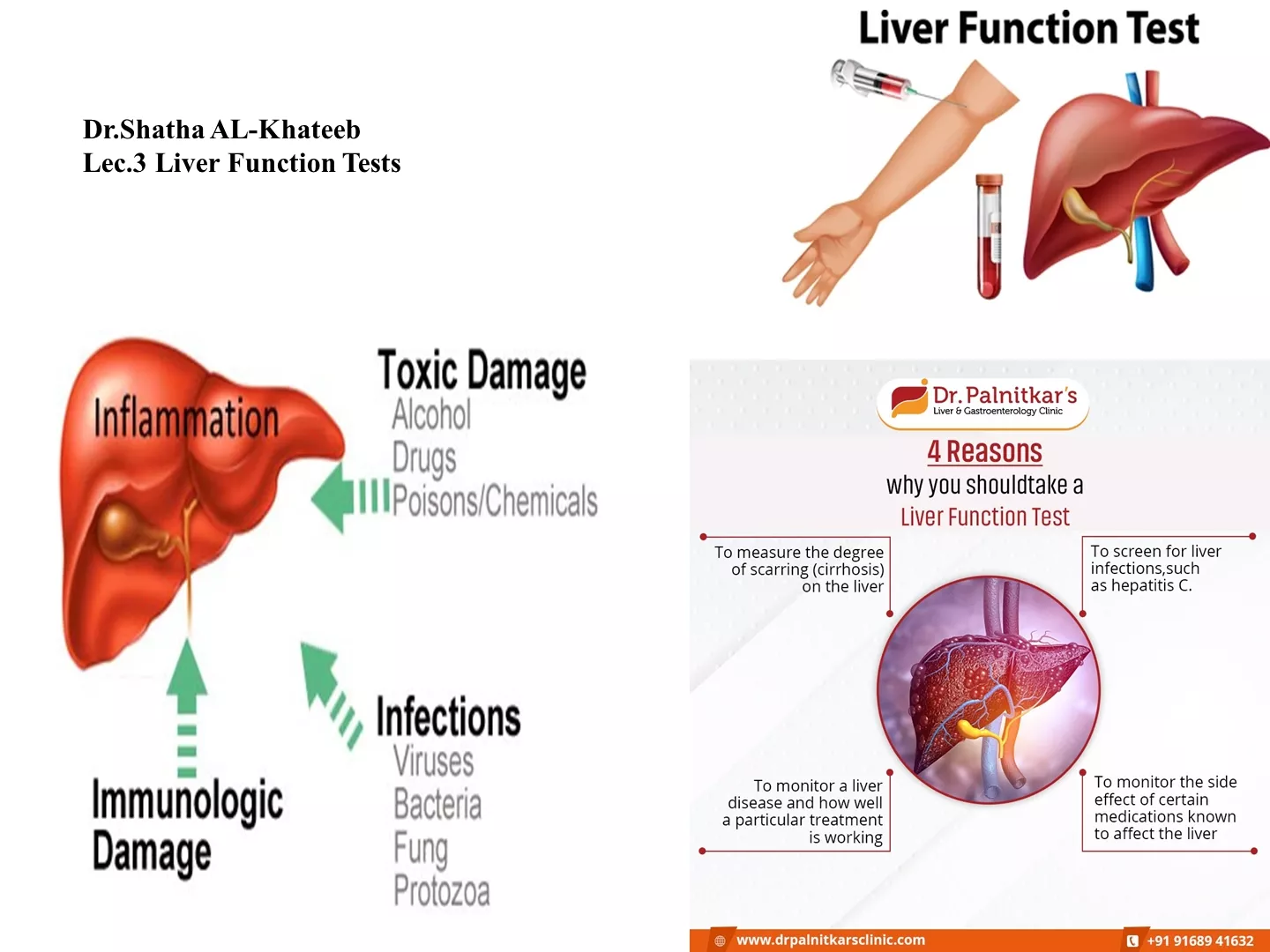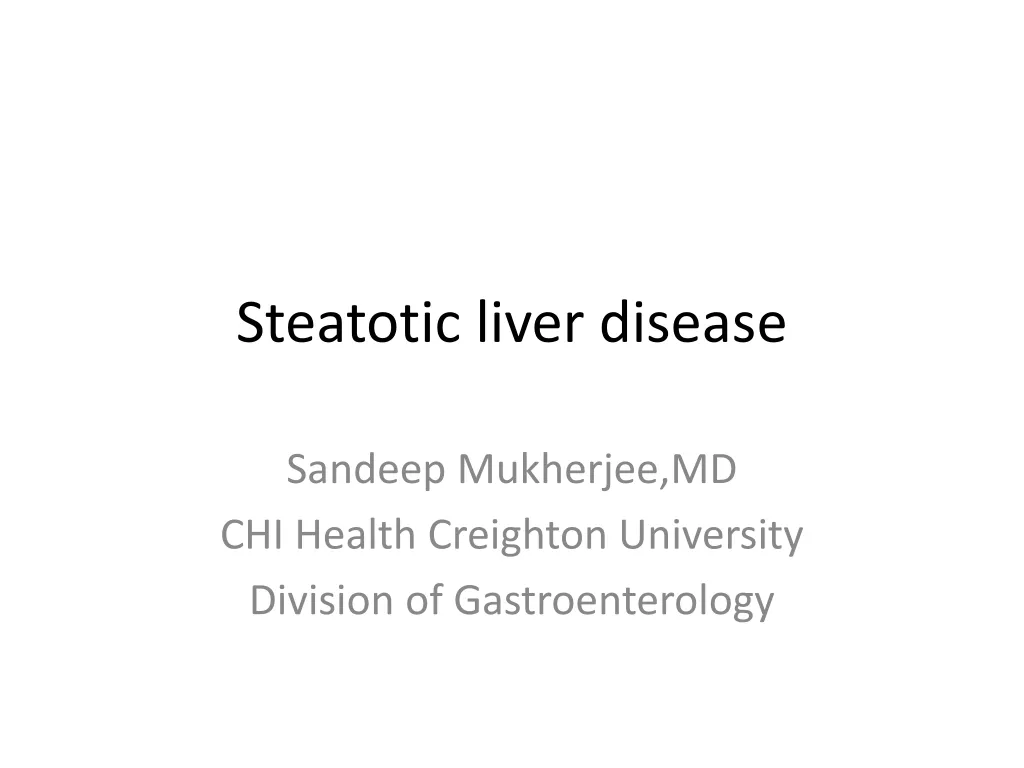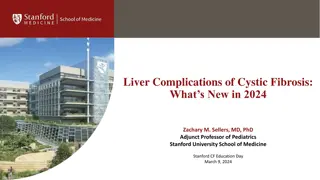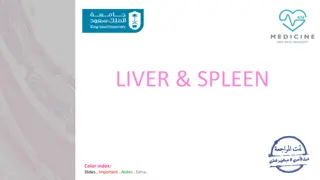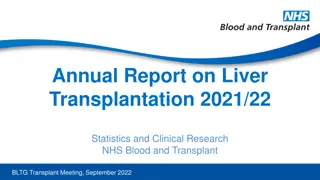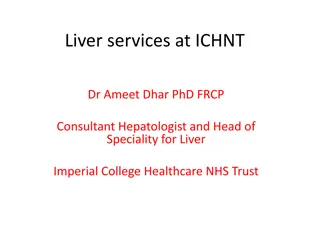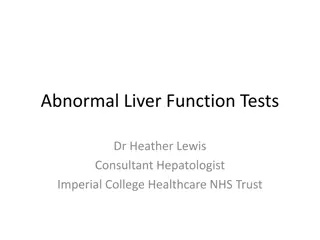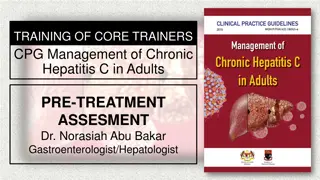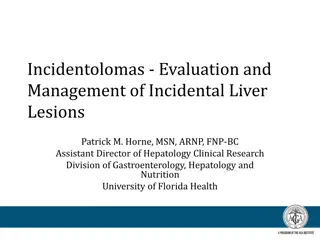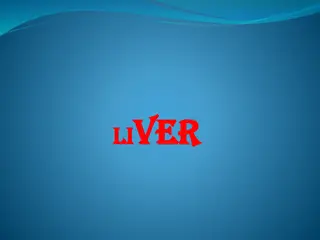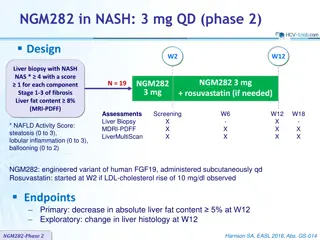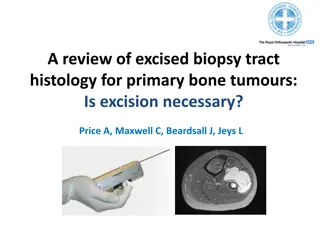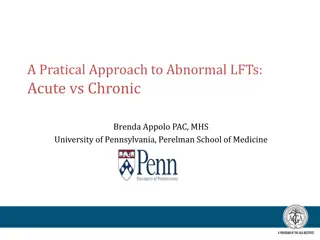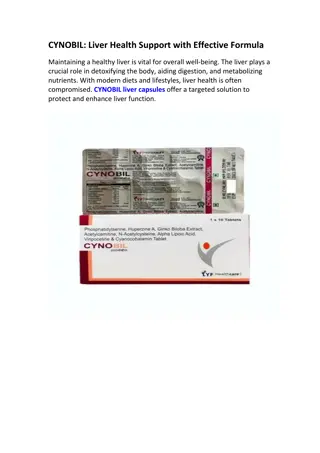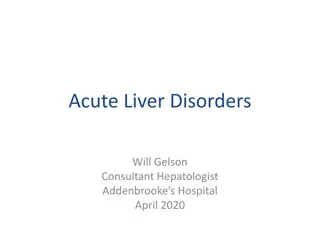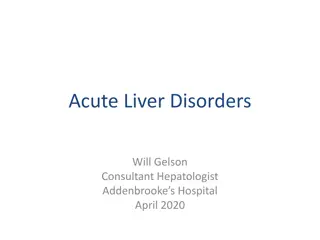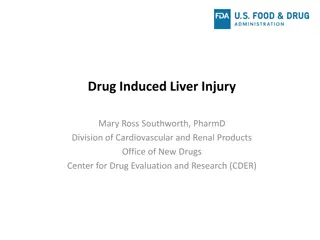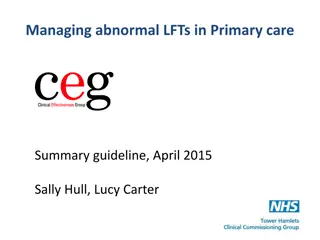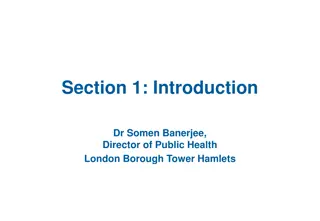Evolution of Liver Biopsy in Children: ESPGHAN Position Paper
Liver biopsy plays a crucial role in diagnosing, staging, and prognostic evaluation of liver diseases in children. Indications for liver biopsy include diagnostic, prognostic, and monitoring purposes. Specific scenarios like neonatal cholestasis and progressive familial intrahepatic cholestasis require liver biopsy for accurate diagnosis and management. The success of procedures like portoenterostomy in diseases like biliary atresia also depends on the accuracy of liver biopsy findings.
Download Presentation

Please find below an Image/Link to download the presentation.
The content on the website is provided AS IS for your information and personal use only. It may not be sold, licensed, or shared on other websites without obtaining consent from the author.If you encounter any issues during the download, it is possible that the publisher has removed the file from their server.
You are allowed to download the files provided on this website for personal or commercial use, subject to the condition that they are used lawfully. All files are the property of their respective owners.
The content on the website is provided AS IS for your information and personal use only. It may not be sold, licensed, or shared on other websites without obtaining consent from the author.
E N D
Presentation Transcript
Liver Biopsy in Children: Position Paper of the ESPGHAN Hepatology Committee Dr.m.b.shetaban 1
2 Role of liver biopsy (LB) in the management of patients with acute and chronic liver diseases has significantly evolved The role to biopsy for diagnosis, staging, and prognostic evaluation has become more specified, and indications have been challenged as information increasingly has become available by routes other than LB. various histopathological techniques, including transmission electron microscopy (TEM)and immunohistochemistry, have enhanced LB interpretation and clinical relevance.
INDICATIONS FOR LB 3 LB can be performed in native or in transplanted liver. The purpose of LB can be diagnostic; it can be prognostic when diagnosis is known and severity needs to be assessed, and it can be to monitor disease progression or response to treatment
LB for Diagnostic Purposes 4 Neonatal Cholestasis In the newborn or extremely young infant, the primary liver diseases overlap with one another and with secondary liver dysfunction (effects of prematurity, asphyxia, or sepsis): the clinical signs of neonatal cholestasis can be identical (hypocholic stools, dark urine, jaundice, hypoglycaemia). Some forms of neonatal cholestasis can be identified biochemically and genetically, or by imaging studies. Others require LB. Although LB at this age may aid in diagnosis, interpretation requires familiarity with various pitfall.
5 Success of portoenterostomy depends in part on age at surgery and some believe that LB or endoscopic retrograde cholangiopancreatography only delays definitive treatment. Clinical findings attain 80% to 90% accuracy in the diagnosis of BA (3). Histopathological evaluation permits diagnosis of BA in 96% of adequate LB specimens: core specimens are adequate if they measure at least 2.0 cm long and 0.2 mm wide, or contain at least 10 portal tracts; wedge specimens are adequate if they contain at least 6 complete portal tracts independent of the liver capsule
Progressive Familial Intrahepatic Cholestasis 6 Diagnosis of progressive familial intrahepatic cholestasis (PFIC) is based on jaundice, elevated serum primary bile acids with low/normal serum g-glutamyl transpeptidase (GGT) activity (familial intrahepatic cholestasis [FIC1] deficiency or bile salt export pump [BSEP] deficiency, normal-GGT PFIC) or with high serum GGT activity (multidrug resistance protein 3 [MDR3] deficiency), absence of dysmorphism, and, as coordinated behaviour emerges, evidence of pruritus. BSEP deficiency and primary bile acid synthesis disorders cannot be distinguished histopathologically without immunostaining.
Alagille Syndrome 7 AGS is largely diagnosed using clinical and extrahepatic criteria, but an important feature paucity of interlobular bile ducts (PILBDs) can only be documented histologically In AGS, PILBD may not be present in young infants; even after age 1 year 25% of AGS LB specimens do not show PILBD (18). LB timing is crucial
a1-Antitrypsin Storage Disorder 8 Only 10% to 15% of individuals deficient in a1-antitrypsin develop liver disease. Because A1ASD can be confirmed by isoelectric protein focusing or SERPINA1 mutation analysis, LB is not required Whether histopathological or clinical findings more helpfully reflect liver disease severity and time prognosis is unclear.
Acute Liver Failure 9 Aetiologies of acute liver failure (ALF) remain indeterminate in approximately 50% of children who require liver transplantation .The role of LB in ALF is limited and questionable. Multisystem impairment and severe coagulopathy make percutaneous LB high-risk, and transjugular (TJ) LB in children requires general anaesthesia, contraindicated unless the patient is already ventilated. Although some conditions causing ALF may be diagnosed histopathologically (25), histopathological study of specimens does not increase the diagnostic in children with ALF (26), and histopathological diagnosis does not alter immediate management.
Cryptogenic Hypertransaminasaemia 10 Although history, examination, imaging, and biomarker and molecular testing clarify aetiology in most cryptogenic hypertransaminasaemia, LB remains standard because it allows for fibrosis staging and grading of inflammation, influencing treatment and prognosis In adults (and children when cause of biomarker abnormalities is initially unclear, non-alcoholic fatty liver disease (NAFLD) is to be considered. Magnetic resonance imaging of steatosis,may also affect LB use in suspected NAFLD. For some conditions (noncirrhotic portal hypertension, nodular regenerative hyperplasia, hepatoportal sclerosis), diagnosis will probably continue to require LB.
NAFLD 11 LB is required for definitive diagnosis of NAFLD but is not proposed in screening. LB is indicated to exclude other diseases, if advanced disease is suspected, before pharmacological or surgical treatment, and in clinical research trials (33).
AIH 12 LB should be performed at presentation in all of the patients with suspected AIH to confirm diagnosis, to grade inflammation, and to stage fibrosis. Coagulopathy and thrombocytopaenia may be postponed LB until empiric immunosuppression ameliorates hypocoagulability. When considering withdrawal of immunosuppression after at least 1 year of complete biomarker remission, LB is mandatory to document absence of inflammation (34).
LB in Assessment of Known Liver Disease 13 Wilson Disease Drug-Induced Liver Injury Sclerosing Cholangitis Congenital Disorders of Glycosylation CHF and Ciliopathies (Fibrocystic Hepatorenal Diseases) Hepatitis B Virus Infection Hepatitis C Virus Infection Cytomegalovirus Infection Epstein-Barr Virus Infection Liver Tumours Liver Transplantation
APPROACH TO LB 14 LB technique is often chosen on the basis of the risk profile in the individual patient, but the choice also depends on personal experience and practice of the clinician. LB is most commonly performed percutaneously,otherwise the TJ or laparoscopic approach can be chosen.
Percutaneous LB 15 Blind LB is done without contemporaneous imaging study (ultrasonographic) guide. The classic manner is the percussion-guided midclavicular intercostal approach. For exclusion of anatomical variation, all of the patients should have undergone an abdominal ultrasound before a blind LB.
16 Ultrasoundassisted LB, in which a hepatologist examines the proposed biopsy site ultrasonographically immediately before LB, can improve the yield of liver tissue and enhance safety (63). Ultrasound-guided or computerised tomography guided LB is chosen either when a focal lesion must be sampled or when features, including obesity, obscure anatomical landmarks used for percutaneous LB. After segmental liver graft transplantation owing to the specific anatomic situation, blind LB is not recommended; ultrasound-guided or -assisted LB is the investigation of choice.
17 Ultrasonographic guidance is associated with decreased rates of hospitalisation in adult The decision whether to use ultrasonography routinely should not be based on economic factors (64). Many physicians prefer guided biopsy for both diffuse parenchymal disease and focal lesions (65). Plugged (Plugged-Tract) LB Plugged LB is a modification of percutaneous LB in whichmcollagen, thrombin, or a comparable material is injected as the needle is withdrawn.
TJ LB 18 TJ LB is performed by interventional radiologists in high-risk patients (with severe liver disease and coagulopathy, pancytopaenia, or ascites) and in patients with an underlying contraindication to percutaneous LB, such as haematological conditions. Potential disadvantages of TJ LB include that tissue samples are small and may be fragmented, both limiting histopathological diagnostic value.
LB at Laparoscopy, Mini-Laparotomy, and Laparotomy 19 Wedge LB under direct observation is recommended only in exceptional settings because the peripheral tissue sampled is less representative of the liver, particularly for staging of fibrosis, than is the standard needle biopsy specimen. The laparoscopic approach may, however, be performed to obtain samples of liver tissue in specific circumstances. Possible benefits of laparoscopy are increased specimen size and immediate control of possible intraprocedural haemorrhage (63,69) and the selection of biopsy site on inspection of the liver (70). A disadvantage is the use of electrocautery, which can substantially impede histopathological interpretation. Cold-knife excision is thus preferable for specimen retrieval, with haemostasis by electrocoagulation afterward. One possibility is needle LB under laparoscopic vision, which allows deeper biopsy sampling and efficient bleeding control as well
Conditions to be considered for laparoscopic LB are as follows: 20 1. Increased risk of bleeding (69) 2. Ascites of unknown aetiology 3. Evaluation of abdominal mass 4. Failure of previous percutaneous LB (71) 5. Requirement for a large biopsy sample for enzymatic analysis, that is, in suspected metabolic conditions
LB DEVICES 21 cutting needles (Tru-Cut, Vim-Silverman and Temno) and suction needles (Menghini, Klatskin, Jamshidi) The diameter used in chronic hepatopathies usually varies between 1.2 and 1.8 mm or 1.6 and 1.8 mm , with length varying from 7 to 9 cm according to patient age. The advantages of smaller suction needles with regard to safety should be weighed against the disadvantages of the smaller LB specimen with regard to adequacy recent study supports the routine use of 16-G rather than 18-G biopsy needles for routine ultrasound-guided LB (75).
22 Specimens from Tru-Cut needles give more information about hepatic architecture. To take >1 liver core at biopsy may increase not only diagnostic yield, but also morbidity When a blind percutaneous LB is performed, taking 2 specimens may improve diagnostic yield, but the numbers of minor complications may increase when >3 consecutive passes are done (76,77).
TYPES OF ANAESTHESIA 23 efforts should be made to reduce anxiety and pain, and to ensure safety of the LB. Based on local practice, general anaesthesia or sedation may be used. use of a long-acting local anaesthetic at the site of biopsy is recommended.
Bleeding 25 significant bleeding events, that is, with haemodynamic alteration or warranting transfusion, occur in approximately 1 of 2500 to 10,000 in adults with diffuse parenchymal disease Bleeding was reported in 2.8% of 469 paediatric procedures, increased with malignancies or after bone marrow transplant (89) A 15%incidence of bleeding in children with oncological disease also was reported (90). routine ultrasonography after LB revealed clinically unsuspected haemorrhage at a rate of 2.6% (7/266) (91). ALF cases were at increased risk for major bleeding.
Pain 26 Pain is the most reported complication, 84% of patients (92). typically occurs at 2 sites: at the LB site and at the right shoulder ( referred pain). pain after LB is mild, well tolerated, and controlled by minor analgesia. Obviously, if pain persist or worsen, urgent ultrasonography is warranted to identify any of the complications.
Arteriovenous Fistula 27 Recurrence are few, are usually presented as case reports, and are rare in children. should be suspected in the presence of an abdominal bruit or in a patient who has who presents with signs of acute portal hypertension, abdominal distension, or liver failure. Management is by emergency closure via either image-guided intervention or surgery.
Pneumothorax and Haemothorax 28 Pneumothorax and haemothorax are not possible complications of percutaneous LB. Only 1 case of pneumothorax has been reported in a paediatric study. In a meta-analysis of studies in adults, incidence was 0.05%; was significantly reduced when ultrasonographic guidance used (98).
Organ Perforation 29 The incidence of viscus perforation following percutaneous LB in adults varies between 0.07% (99) and 1.25% (100), and in children, it is unknown. It should, however, be suspected when the course after LB is abnormal or is marked by substantial pain. Management can be surgical or expectant
Bile Leak and Haemobilia 30 In a large meta-analysis of adult TJ LB, the incidence of biliary fistula was 0.01% and that of haemobilia was 0.04% (98). In a cohor tstudy on 1500, only 1 case of biliary peritonitis occurred; it was fatal (101) Bile leaks have been reported after 3 paediatric LB procedures (0.6%) (89). Embolisation is preferred for the management of uncontrolled haemobilia Infection Infection, site or systemic, is a possible complication of percutaneous LB, but its incidence in adults is extremely low Although comparable data do not exist for children,
Death 31 In children, 3 deaths have been reported in 469 LB (0.6%), all with a history of malignancy or haematological disease (89). Two recent studies have reported no deaths Two deaths before the implementation of TJ LB have been reported for oncological disease patients (90). Our review suggests that haemato-oncology patients are at increased risk for major bleeding and death after LB. To consider these patients as at high risk seems justified, TO do cautionary measures to limit complications, in particular bleeding. TJ LB may be safer than percutaneous or open LB.
Needle Size, Needle Diameter, and Number of Passes 33 Increases in calibre of LB trocar and in number of passes are thought to predispose to complications, including bleeding. Data from adult studies and in animal models are, ambiguous, permitting no firm conclusions In conclusion, data are scant on complications following paediatric percutaneous LB, TJ LB, or plugged LB. Small infants and patients with increased cancer or haematological disease appear at risk for bleeding, as may be patients with AGS No convincing evidence exists that ultrasonographic guidance either before or during LB reduces complication rates
Special Populations 34 Patients with end-stage chronic renal disease Patients with AGS or with arthrogryposis-renal dysfunctioncholestasis (ARC) syndrome Young infants Infants <3 months of age may be more likely to have sedation complications than are children in the general Low-birth-weight babies
35 Platelets: A count of 60 or lower may represent an indication for platelet transfusion The above recommendations do not consider platelet function, best be evaluated by bleeding time increased fibrinolysis is common in advanced liver disease. Supplementation should be considered if the plasma concentration of fibrinogen is <1.0 g/L. Finally, patients with abnormally prolonged activated partial thromboplastin time should evaluated for milder forms of haemophilia and for von Willebrand disease a thorough enquiry into personal and family histories of bruising and mucosal bleeding is mandatory.
Ascites 36 LB in a patient with voluminous ascites should be avoided The risk of haemodynamic complications is increased, particularly in smaller children, because of bleeding and/or biopsy site leakage of fluid, which could lead to peritonitis. Without imaging study guidance, the safety and diagnostic yield of LB are often poorer, because the correct position of the liver is more difficult to ascertain.
Specific Patient Categories 37 haemato-oncological patients, in particular after haematopoietic stem cell transplantation, are at increased risk Percutaneous LB in patients during sickle cell crisis should be avoided if possible In case of suspected haemophagocytic lymphohistiocytosis LB should also definitely be avoided.
38 To minimise risk of complications, ultrasonography should be performed before LB to identify contraindications such as ascites, biliary dilatation, peliosis, or haemangioma and anatomic variation such as abdominal situs inversus How often hepatic haemangiomata occur in the general paediatric population is unknown, but the prevalence in adults is 1.5% (125). Abdominal situs inversus is estimated to occur in 1:10,000 to 1:25,000 individuals
Before LB 39 1.Informed consent 2. Sedation/anaesthesia 3. Haematological testing Before percutaneous LB all of the patients should undergo these laboratory investigations: a. full blood count determination of indices of hepatobiliary injury, total and direct serum bilirubin, alanine aminotransferase, aspartate aminotransferase, alkaline phosphatase, GGT, prothrombin complex time (PT)/INR, activated partial thromboplastin time, and fibrinogen. Bleeding time determination could be considered if platelet dysfunction is suspected. In most cases PT/INR and platelet count should be checked within the 24 hours
40 4. Ultrasonography before 5. Therapeutic management before LB Patients undergoing LB should observe some therapeutic recommendations: a. Antiplatelet therapy (except low-dose aspirin given after liver transplantation) should be discontinued at least 7 to 10 days before and be restarted 48 to 72 hours after b. Warfarin; should be discontinued 5 days before and may be restarted 24 hours after LB; administration of heparin and related products should be interrupted 12 to 24 hours before
41 c. In patients with valvular heart disease, documented bacteraemia, or chronic cholangiopathy after liver transplantation, periprocedural intravenous antibiotic prophylaxis should be administered d. If a history of hypoglycaemia exists, an intravenous infusion of glucose should be started to maintain blood glucose levels during fasting before LB.
LB: THE PROCEDURE 42 1. Patients should fast for 4 hours before LB;may vary depending on age, clinical condition, and local policy. Vital signs, including heart rate, respiratory rate, arterial blood pressure, and core body temperature, should be assessed 1 hour before LB (63,74,76). 2. The patient should lie supine position with the right arm placed behind the head. After sedation/anaesthesia, long-acting local anaesthetic (ie, bupivacaine 0.5%) should be topically infiltrated of (63,73,74) into skin and soft tissue at the region of maximal dullness at percussion between the 7th and 9th intercostal space or in a more appropriate site if bedside ultrasonography is performed (127). 3. The region of the needle entry must be cleaned with an alcoholbased solution and draped with sterile cloths (63).
43 4. The needle must be introduced in the right mid-axillary line above the rib; if ultrasonography is not available and the operator uses an intercostal approach, the needle should be introduced 1 intercostal space below the superior margin of liver dullness. If the operator uses a subcostal approach, the needle should be introduced in the midclavicular line below the costal margin (Fig. 1).
44 5. LB with ultrasonographic guidance reduces complication rates, as it permits directing biopsy away from gallbladder, vascular structures, colon, and lung (63,76). Real-time ultrasonographic guidance helps in finding the most suitable site to perform LB and allows reducing the number of passes into the liver. Furthermore, liver parenchyma could be identified without extreme ventilatory movements (63). It should be emphasised that after liver transplantation, using only anatomical landmarks to guide the site of biopsy is insufficient; image- guided LB (eg, ultrasound) is recommended. 6. The LB specimen should be handled according to agreed local protocol modified to accommodate diagnostic considerations in the individual patient (see above).
After LB 45 1.Immediately after LB the needle entry site should be firmly compressed to procure haemostasis. The patient should fast for approximately 2 hours after LB and vital signs (blood pressure, heart rate, respiratory rate) should be monitored closely for at least 6 hours after LB (127). Oxygen saturation monitoring also is advised (74,76). 2. The patient should remain in bed for a minimum of 1 hour after LB or until vital signs are stable.
46 3. If bleeding is suspected, a full blood count may be requested. The interpretation of this needs to take into consideration that a detectable decrease in the haemoglobin value needs some time to develop. ultrasonography may also be required for the assessment of bleeding complications. Laparotomy or image-guided embolisation may be required for life-threatening bleeding (127). If pneumothorax is suspected, posteroanterior and lateral chest roentgenograms may be useful. 4. Determinations of serum haemoglobin concentration and haematocrit should be considered only if clinically justified.
47 5. The patient should be observed for at least 6 hours for signs or symptoms that suggest complications, such as severe pain, shoulder pain (in older children), irritability (in infants), bleeding, discharge at LB site, difficulty in breathing, pallor, and fever (132). 6. LB is often performed in an outpatient setting, but many units prefer 1 overnight stay. 7. Contact sports should be avoided during the first week after LB.
